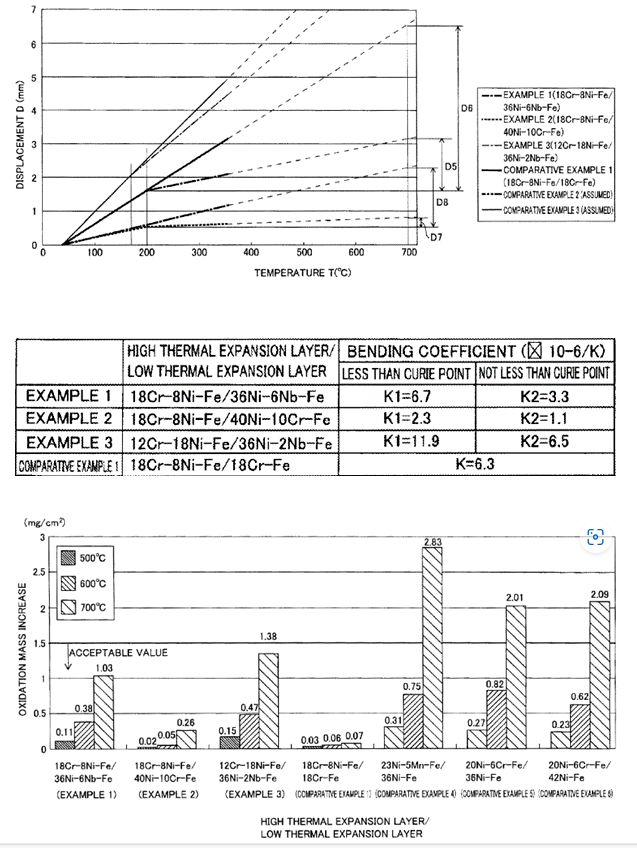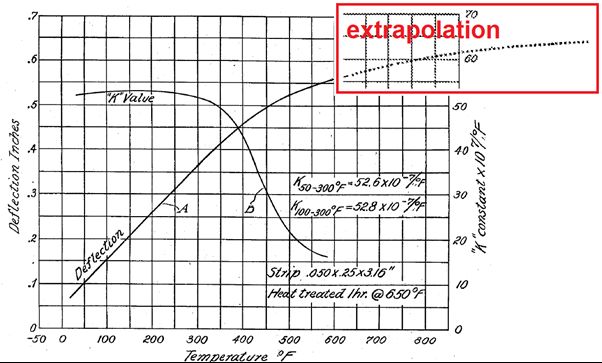On October 3, 2023, the Patent Trial and Appeal Board (PTAB) reversed an examiner's finding of obviousness based (i) on mischaracterizing a claim feature as an intended use, the feature instead being considered by the PTAB as a characteristic of the composition of the claimed article, and (ii) extrapolating a trend in the cited art without explicit support for the extrapolation. The appeal (No. 2022-003575, USSN 13/375,167, Technology Center 1700) of Ex parte YOSHIMITSU ODA and MASAAKI ISHIO was centered on an independent claim, reciting:
[a] thermosensitive deformation
apparatus comprising:
a high-temperature bimetal plate made of a two-layered
cladding material consisting of
a single high thermal expansion layer made of austenitic
stainless steel, and
a single low thermal expansion layer made of a thermosensitive
magnetic metal having a Curie point and pressure-bonded directly to
said single high thermal expansion layer, wherein a thermal
expansion coefficient of the single high thermal expansion layer is
higher than a thermal expansion coefficient of the single low
thermal expansion layer; and
a fixing member fixing an end of the high-temperature bimetal
plate,
wherein opposite end of the high-temperature bimetal plate is
a free end which is not fixed,
wherein a range of an operating temperature is
over both a high temperature range of not less
than said Curie point and a low temperature range of less than said
Curie point, wherein an upper limit of operating temperatures in
said high temperature range of not less than said Curie point is at
least 500°C,
wherein said high-temperature bimetal plate is formed to bend
resulting from a deformation by rising temperature,
wherein a bending coefficient in said high temperature range
of not less than said Curie point is smaller than a bending
coefficient in said low temperature range of less than said Curie
point,
a range of said operating temperatures in said high
temperature range of not less than said Curie point is larger than
a range of operating temperatures in said low temperature range of
less than said Curie point, and
a thickness of said single low thermal expansion layer is
larger than a thickness of said single high thermal expansion
layer.
The claims were rejected by Examiner Lisa Chau, supervised for more than seven years of prosecution by Primary Examiner Holly C. Rickman, under Supervisory Patent Examiner Callie Shosho. Supervisor Patent Examiners Shosho and Mark Ruthkosky were conferees in the decision to take the case to the PTAB. This case appears to confirm a trend of junior examiners being coached into rejections rather than accepting the allowability of claims or suggesting claims which could be allowable. The applicant in this case received 13 office actions from Examiner Cox, including one negative Pre-Appeal Brief Request for Review (signed by the same three examiners, June 6, 2017), one office action on May 30, 2023, re-opening prosecution after the filing of an appeal brief, and ultimately the Examiner's Answer on May 12, 2022, to the second full appeal brief, signed by Examiners Chau, Shosho, and Ruthkosky.
The main claim of the appealed application, with the final clause reciting much of the substance relied on by the PTAB to reverse the position taken by the examining corps, on entry of the US national stage on January 29, 2011, recited the following:
[a] high-temperature bimetal
comprising:
a high thermal expansion layer (2) made of austenitic
stainless steel; and
a low thermal expansion layer (3) made of a thermosensitive
magnetic metal having a Curie point and bonded to said high thermal
expansion layer,
the high-temperature bimetal being employed over both a high
temperature range of not less than said Curie point and a low
temperature range of less than said Curie point, wherein an upper
limit of operating temperatures in said high temperature range of
not less than said Curie point is at least 500°C.
The Curie point (or Curie temperature), recited in the claim is
the temperature above which a material loses its permanent magnetic
properties, which can (in most cases) be replaced by induced
magnetism. The applicant amended the above claim on March 1, 2015,
after a first substantive office action from March 16, 2015, inter
alia, to recite for the final clause, "...wherein the
high temperature bimetal being thermosensitive
deformation apparatus is to be employed over
both a high temperature range." The bolded phrase "is to
be," appears to be significant to the fixation of the
examining corps upon the "intended use" construction,
which it applied against the claims for the remaining 8 years of
prosecution.
In response to this amendment, the examiner argued that the "high temperature range" recited in the claim is "merely a variable to recite a specific property, bending coefficient (i.e. test, measure, or subject the high-temperature bimetal in a certain variable (temperature) will produce a certain property or outcome, when in use/tested)" and that a cited reference, Fraisse (US 2006/0192181 A1), "teaches substantially the same claimed structure and materials" and thus the property would inherently flow from Fraisse, combined with other references. The examiners' incorrect construction that the operation temperature of at least 500°C merely required ability to be used for any purpose taught by the art at that temperature, rather than to work as a "thermosensitive deformation apparatus." The function as a thermosensitive deformation apparatus was agreed by the PTAB to imply certain bending characteristics.
The Fraisse reference relates to a ferromagnetic to allow for induction-heated cooking utensils, and was argued to teach the opposite of the claimed deformation effect, i.e., to avoid deformation, and not to have the structure of several claim formulations presented prior to appeal. Further references were argued to fulfill the construed operation suitability, with the appeal being centered on the combination of references including Waltenberg (US 2,332,416), also combined with Fraisse.
The appealed application disclosed the following results from the inventive examples versus the comparative examples in FIG. 8, 10, and 11.

The appealed application did not experimentally illustrate the failure of one or more similar formulations in the cited art to be able to perform the claimed function, i.e., thermosensitive deformation in a low and high temperature range, wherein the operating capability is maintained from 500°C upwards. Instead, the comparative examples in the appealed application showed a situation without a Curie point in one layer of the bimetal. As seen in FIG. 11, certain bimetals were shown by the applicant to be above an "acceptable value," and thus prone to distortion. Therefore, a distinction of the claims from the cited art was in the ability of the bimetal to function as a "thermosensitive deformation apparatus" without distorting the bimetal, e.g., from contacting a stopper, as discussed in the background section of the appealed application.
After several years of prosecution, on February 13, 2020, the applicant modified the clause in question to recite:
the thermosensitive
deformation apparatus is to be employed a range of an
operating temperature is over both a high temperature range of
not less than said Curie point and a low temperature range
of less than said Curie point, wherein an upper limit of operating
temperatures in said high temperature range of not less than said
Curie point is at least 500°C.
However, this modification of the recitation did not shake the examiner from the intended use construction. Furthermore, the new "operating" language did not convince the examiner that the ability to be used for any purpose under certain conditions does equate to the ability to be used for the particular purpose claimed.
This inability to function for the particular purpose claimed (also as a characteristic of the selection and combination of materials), was then relied upon by the PTAB to reverse the position taken by the examining corps. Theoretically, the lack of a reason in the prior art to select a composition to have the function for the particular purpose claimed could have been argued, but case law in the Federal Circuit can make such arguments difficult.
In the end, the PTAB overturned the examiners on the basis that no evidence was provided that Waltenberg could function as a thermosensitive deformation apparatus at a temperature of at least 500°C. The examiner had modified Waltenberg's figure to extrapolate the temperature curve with no support for the modification, as shown below as the hyphenated extension to the curve.

The PTAB made the straightforward assertion that the examiner had failed to provide evidence that "Waltenberg's bimetal continues to deform to at least 500°C (i.e., 932°F) as depicted above." The PTAB did not make a statement on whether Waltenberg would have rendered the claims obvious had there been evidence that it followed the above curve, or something similar. Notwithstanding, the failure to provide clearly distinguishing evidence on the part of the applicant was seen by the PTAB to be less problematic than the examiners' incorrect intended use construction combined with a self-drawn extrapolation of prior art data.
This case is a reminder that it is important to clearly explain why a claim feature is not an intended use, but instead a characteristic of the materials / apparatus, and preferably avoid using "for [intended use]" or "to [do]" in the claim language. Intended uses generally only serve to distinguish US method claims, which are basically the "use. "Furthermore, this case illustrates that, if possible, an applicant should provide a counterexample of formulations / alloys described as equivalent by the prior art failing to perform the function claimed or otherwise failing to perform satisfactorily.
A possible issue preventing the applicant from rebuttal with evidence to the contrary was that the broad prior art description could have indeed provided a functioning device as claimed, were one to apply the hindsight of knowledge of the invention, as the USPTO does in obviousness findings. As can often be the case with metallurgical inventions before the USPTO, references with little relationship to the problem solved by the claims or the closest prior art can be used under the "overlapping ranges" or "close ranges" obviousness rationales robotically applied by the USPTO examining corps. Many applicants may recognize this as associated with Titanium Metals Corp. of America v. Banner,778 F.2d 775, 783, 227USPQ 773, 779 (Fed. Cir. 1985).Under the USPTO's "range" case law, patent applications in the prior art often recite fantastically broad compositional ranges for divergent metals as "possible" or tolerable, and can place an applicant into prima facie obviousness without the prior art providing any actual basis to solve the problem the new invention solves.
In such situations, if there is any counterexample falling within ranges described as equivalent or acceptable by the prior art that can be shown experimentally not to achieve the requirements of the claims, this counterexample should still be produced and submitted to the USPTO if possible. The counterexample in such a case does not need to be disclosed in a US application at all to serve as experimental evidence.
The content of this article is intended to provide a general guide to the subject matter. Specialist advice should be sought about your specific circumstances.


